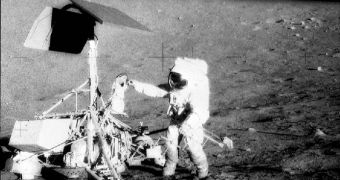The Moon's gravity is one sixth of that on the surface of the Earth, meaning that lunar landers do not require a great deal of thrust in order to decelerate and land relatively gently on its surface, but what seem like gentle touchdowns to us here on Earth, on the Moon such events can get relatively violent. Like the landings of the Apollo Lunar Modules between 1969 to 1972.
As they slowly approached the lunar surface, high velocity gases emitted by the engines disturbed the dusty surface of the Moon in such a way that Apollo astronauts reported to have seen the dust clouds generated by the blast, fading away over the horizon. Because it has a basically inexistent atmosphere, the Moon cannot absorb the energy carried by such dust clouds and sometimes ends up covering distances as long as half way around the Moon, or more, before they encounter a natural structure, which finally stops them.
Some can even reach speeds up to 8.640 kilometers per hour, enough to escape the Moon's gravitational field and wander into space, before entering orbit around the Sun. By performing simulations on how the exhaust gases behave in vacuum environments, Forrest Lumpkin, from the Johnson Space Center, was able to understand the mechanics of the dust storms produced by the landing of Apollo Lunar Modules, and how do exhaust gases interact with the lunar surface.
Correlating those results with measurements of the shadows, created by the blast of the landing of the Lunar Modules, revealed that in fact the exhaust gases packed enough thrust to move rocks fifteen centimeters in diameter. This doesn't present much of a problem for future manned missions to the Moon, as rocks so large should travel relatively small distances before being brought down to the surface by Moon's gravitational field; however, as you have seen earlier, smaller dust particles could reach phenomenal speeds and travel half way around the Moon.
This means that a spacecraft standing in the way of the dust cloud would basically get sandblasted. The effect has been demonstrated in 1969, when Apollo 12 Lunar Module landed only 180 meters away from the Surveyor 3 robotic probe. While examining Surveyor 3, the Apollo 12 crew observed that, on one side, the probe was darkened by radiation, but on the side facing the Lunar Module, the darkening was removed by the cloud of dust.
Although it may seem like an useful effect, it is anything but that, because this means that dust could be forced into lunar equipment, to destroy vital parts, or to jam mechanisms. Further still, as the astronauts inspected the Surveyor 3 camera, they were shocked to discover dust particles inside it. Fine dust particles created microcrates as large as 60 microns, creating a spider-like pattern all across the paint of the probe.
Philip Metzger of NASA's Kennedy Space Center says that special precautions must be taken in order to protect ourselves from such effects. In the possibility that a lunar outpost would be created on the surface of the Moon, we may need to imply protection methods, such as the use of natural terrain to block the dust clouds, or to build artificial terrain, and why not, to prevent the formation of such phenomenon altogether.

 14 DAY TRIAL //
14 DAY TRIAL //